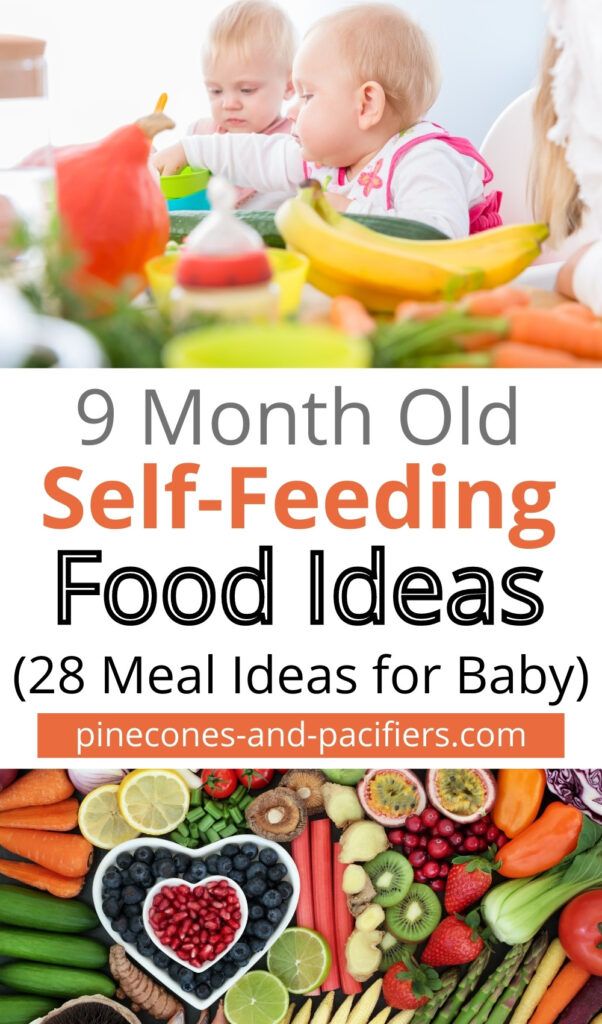How to cook chicken for baby finger food
Chicken for Babies (with recipes)
Jump to Recipe
Introduce chicken to your baby with confidence with these cooking tips and recipes! Whether you are doing purees, baby led weaning, or both, chicken is a wonderful first food, loaded with iron.
Jump to:- When to introduce
- Health benefits
- Is chicken safe for babies?
- Top 4 Cooking Methods
- How to Serve for Baby Led Weaning
- Frequently Asked Questions
- Chicken Recipes for Baby
- Additional Resource
- How to Cook Chicken for Babies
When to introduce
Chicken can be offered to babies as soon as they’re ready to start solids, usually around 6 months. It’s important to remember that your baby is unique and that rather than going by the calendar, you need to make sure your baby is DEVELOPMENTALLY ready to start solids.
If you’re unsure, be sure to grab my FREE handout!
Health benefits
Just like with beef, chicken is an excellent source of iron, arguably THE most important nutrient for babies. It's also a great source of (highlighting a few):
- Zinc - Necessary for making protein and DNA, aids in immune function and cognition
- Choline, vitamins B6 and B12 - Important for optimal brain development, metabolism and maintaining a healthy nervous system.
- High-quality protein - Chicken contains all the essential amino acids, or building blocks, of protein that are necessary for our babies to grow and thrive!
Related: Best First Foods for Babies
Is chicken safe for babies?
First, I want to reassure you that babies do NOT need teeth to eat meat or any other finger food for that matter. You’ll be amazed by how strong and capable their gums are! Will your baby gag? Most likely, just like with any food, even purées! And this is actually a good thing!
I discuss more in this post - how to start baby led weaning.
However, you need to make sure chicken is cooked properly and served in an age-appropriate way.
I highly encourage you to Invest in a good meat thermometer so you can check the internal temperature for not only chicken but any meat/poultry.
Chicken is safe to eat when its juices run clear, the inside is no longer pink (although sometimes it can still have a pinkish tint), and the thickest part of the meat reaches at least 165° Fahrenheit.
How to serve the right size and texture
Top 4 Cooking Methods
Here are the top ways to prepare chicken, including the cooking times. I am specifically showing you how to cook chicken breast, as it is the most difficult cut to cook properly. Say no more to dry, tough meat.
Important tip: To avoid overcooking and uneven cooking, take the chicken out 30 minutes before cooking. Don't worry. It can safely sit on the countertop for up to 2 hours (or 1 hour if inside temperature is above 90°F). Otherwise, if you cook an ice cold piece of chicken, the outside will dry out before the inside gets fully cooked.
Poaching
In a pot, place the chicken breasts in a single layer. Cover with water or broth. You can add some herbs or a bay leaf. Bring to a boil, then quickly reduce heat to low, cover, and simmer for 10-15 minutes. Make sure the thickest part of the meat reads 165°F.
Bring to a boil, then quickly reduce heat to low, cover, and simmer for 10-15 minutes. Make sure the thickest part of the meat reads 165°F.
Roasting (with a twist!)
Juicy, tender, flavorful chicken breast - here we go!
If you haven't tried steam roasting yet, you MUST! Here's an in-depth explanation of this cooking method.
It's seriously the BEST way to cook meat/poultry and vegetables for babies and toddlers!
Not only will it save you time and energy but it will also result in that perfectly safe texture for babies.
steam roasted chicken seasoned with curry powderAnother big advantage of this method is that you can season your chicken for extra flavor before putting it in the oven. I actually prefer this over poaching.
Simply add the chicken (seasoned or not) to a baking dish, cover, and allow for it to bake in its own juices!
Marinate with yogurt
I know it may sound strange BUT this method of cooking is AH-MAZING! Be sure to give it a try!
Instant Pot or Pressure Cooker
Add water to the IP, insert trivet, and add chicken. Cook on high pressure for 8-10 minutes. Once it beeps, wait 5 minutes then release pressure.
Cook on high pressure for 8-10 minutes. Once it beeps, wait 5 minutes then release pressure.
How to Serve for Baby Led Weaning
Cook the chicken using any of the methods above or try my recipes that your ENTIRE family can enjoy together (sharing below). Then make modifications according to your baby's age.
6-8 months baby
Chicken puree - Cook chicken and blend with broth, water, or breastmilk. Serve on its own or mixed with veggies. And don't forget to add seasonings.
Do keep in mind, it’s important to move forward with texture by 9 months at the latest. Here’s how to transition baby from puree to table food.
These are actual meals I served to my babyServe as a finger food - Big strips (1-2 inch wide), drumstick, a whole meatball are all great!
I know this might sound counterintuitive, BUT bigger is better and safer for this age! Your baby will grab with their palm and suck on the juices, which is wonderful! Your baby is getting exposed to flavor, texture, and iron.
These are my top meatball recipes. You can easily substitute with ground chicken
- Asian Turkey Rice Meatballs
- Butternut squash baby beef meatballs
- Baked quinoa and mushroom meatballs
- Turkey beet meatballs
Finely chopped/minced - If you are anxious about serving a large piece, then go really small. You can do this by hand or I like to use this mini manual food chopper!
And then the sky’s the limit! Add to oatmeal, lentils, pasta, mashed avocado, etc.
8-12 months old baby
Once your baby is able to tear or break off a large chunk of meat, it is no longer safe. Go smaller by serving thinner strips (about the size of your pinky finger) or shred.
12+ months
served with broccoli hummus, naan, steam roasted broccoli and carrotsAt this age, you can cut into bite-sized pieces, making sure they are not cubed. Also, encourage the use of utensils by providing them with plenty of opportunities to practice. Be consistent and patient as it's a skill that takes a while to master.
Be consistent and patient as it's a skill that takes a while to master.
Frequently Asked Questions
What part of chicken is good for babies?
Both dark and white meat are excellent! Dark meat does have a higher fat content, though, which helps keep the meat juicy and tender. But by following the cooking instructions I shared above, chicken breast can also provide a great flavor and texture experience for your baby.
Can you season for babies?
Absolutely! I highly advise you to have fun with all kinds of herbs and spices! It's such an easy way to invite variety and flavor, without the use of salt.
How to store cooked chicken?
You can slice, shred, and store in an airtight container in the fridge for up to 4 days or freeze for up to 3 months
How do I reheat?
I've found that the best way is on the stove. Add enough water (or broth) to a skillet over medium heat and bring to a simmer. Add chicken, cover, and cook until warmed through.
Add enough water (or broth) to a skillet over medium heat and bring to a simmer. Add chicken, cover, and cook until warmed through.
How do I freeze?
Transfer to a freezer safe bag or container. I recommend freezing in individual portions. It will keep for up to 3 months. Thaw in the fridge overnight.
Chicken Recipes for Baby
Here are some baby-friendly dishes that the entire family can enjoy together! Once cooked, modify the chicken by following the serving suggestions according to your baby's age as mentioned above.
- Instant Pot peanut chicken
- Chicken quinoa spinach casserole
- Instant Pot Korean chicken and potatoes
- Orange sesame chicken with vegetables
- curry chicken avocado salad
- Low sodium moo goo gai pan
There are more recipes in my cookbooks.
Additional Resource
Are you:
- getting ready to start or at the beginning stage of introducing solid solids and feeling overwhelmed?
- stuck on purees and having a really difficult time transitioning to table food?
- or tired of serving the same foods on repeat and want to offer more variety of foods to your older baby or toddler?
Here's my 3 MONTH Baby Led Feeding Journey Program!
It's a complete roadmap that would show you through daily videos and photos of what foods and how to serve them to your baby AND the rest of the family at the same time. Everything you need to know all in one place!
Everything you need to know all in one place!
Do you want to minimize picky eating and set a solid foundation for a lifetime of healthy eating habits?
Check out this 3 month mastering self-feeding program! It’s the closest thing to me being in your kitchen
Did you make this recipe? Leave a rating below and let me know how you liked the recipe! Your feedback means so much to me!
How to Cook Chicken for Babies
Introduce chicken to your baby with confidence with these cooking tips and recipes! Whether you are doing purees, baby led weaning, or both, chicken is a wonderful first food, loaded with iron.
5 from 1 vote
Print PinPrep Time: 5 minutes
Cook Time: 30 minutes
Total Time: 35 minutes
Servings: 6
Author: Min | MJ and Hungryman
- ▢
Meat thermometer
- ▢
Baking Mat
- ▢
Parchment Paper
- ▢
Instant Pot
- ▢
Steamer
- ▢ 1 (6-8 ounce) chicken breast, or more if you want to make a large batch (See note)
- ▢ Optional: herbs and spices of choice, don't be shy
Poaching chicken
Place chicken in a pot and cover with water.
 If cooking more than one breast, make sure to place them in a single layer.
If cooking more than one breast, make sure to place them in a single layer.Bring water to a boil. Quickly reduce heat to low and simmer, covered, for 10-15 minutes. It's done when the thickest part of the meat reaches 165°F.
Steam Roasting Chicken
Heat oven to 400°F. Lightly grease the bottom of a raised baking pan. Pat the chicken dry and rub with oil and any herbs/spices you desire.
Place chicken in the pan and cover with parchment paper or silicone baking mat. You can use foil if you prefer.
Place in the oven and cook for 25-35 minutes, until the thickest part of the meat reaches 165°F.
Instant Pot Chicken
Place inner pot into the IP and pour 1 cup of water or broth. Place the trivet and place chicken (seasoned or not) on top of the trivet in a single layer. Close the lid.
Make sure valve is set to sealing. Pressure cook on high for 8-10 minutes.
When it beeps, allow the IP to release naturally for 5 minutes then quick release remaining pressure.

Insert a thermometer and make sure the thickest part of the chicken reads 165°F. If not, secure the lid and cook for an additional 2-5 minutes on high pressure.
Tip: save the liquid for homemade chicken broth! If you want to shred, leave about ½ cup liquid at the bottom of the pot, place chicken back in and shred.
- For all of these cooking methods, take the chicken out 30 minutes before cooking.
- Once done cooking, let it rest for at least 5 minutes before slicing.
- You can slice, shred, and store in an airtight container in the fridge for up to 4 days or freeze for up to 3 months
Calories: 43kcal | Protein: 8g | Fat: 1g | Sodium: 44mg | Calcium: 2mg | Iron: 2mg
Course Main
Cuisine American, baby food
Tried this Recipe? Tag me Today!Tag me @KidFriendly.Meals today!
Chicken for Babies - First Foods for Baby
When can babies eat chicken?
Chicken may be introduced as soon as a baby is ready to start solids, which is generally around 6 months of age.
Need ideas for the best first foods for babies? See our guides.
History and uses of chicken
Thousands of years ago, humans domesticated a scrawny fowl that had been running wild in the jungles of South Asia since prehistoric times. From that agricultural innovation came the bird we know and love today. In our modern era, 50 billion chickens are raised as a source of meat and eggs each year. How did the scrappy junglefowl become one of the world’s most consumed proteins? A mix of technological, cultural, and historical forces over centuries have helped ensure a chicken in every pot. Genetic and agricultural strategies have turned the lean-and-mean bird into plump poultry with maximized egg production. These efforts continue today, with lab-grown meat that is spurring conversation around ethics, sustainability, health, and the future of the bird.
Almost the entire chicken can be used to cook delicious dishes, from pâtés of iron-rich chicken liver; to protein-packed stocks filled with collagen from the carcass, feet, and head; to schmaltz, a flavorful fat extracted from the skin.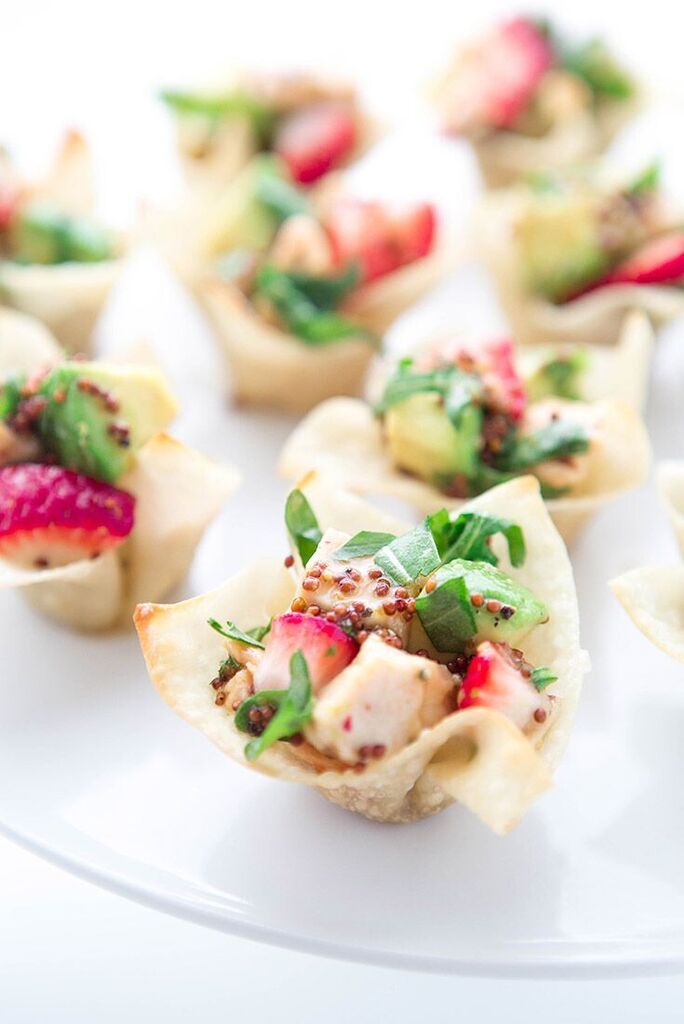 Introducing chicken to babies can be as easy as passing a drumstick—a terrific shape to hold and munch.
Introducing chicken to babies can be as easy as passing a drumstick—a terrific shape to hold and munch.
Is chicken healthy for babies?
Yes. Chicken contains many nutrients that babies need to thrive, including vitamins B6 and B12, iron, zinc, choline, selenium, and vitamin B3. Together, these nutrients help support antioxidant activities, fuel cell energy, create healthy blood, promote a strong sense of taste and smell, and boost brain health. Chicken is also a great source of protein, with the full spectrum of amino acids that help develop a growing baby’s brain, muscles, nervous system, heart, skin, and hair.
There are many labels for chicken. Free-range, organic, vegetarian-fed, cage-free, pasture-raised… What do they mean, and which one is best? Labels can help consumers, but sometimes they can be misleading. Some chickens are “vegetarian-fed”, which suggests a certain quality, but the label often means the birds are eating commodity grains like corn and soy. “Free-range” and “cage-free” chickens have access to the outdoors where they can eat a more natural diet of worms and bugs in addition to plant-based foods. Unfortunately, outdoor space is often limited, and many birds do not venture outside; instead, they remain in their (often overcrowded) grow houses where they eat commodity grains. Even “organic” chickens are not necessarily raised outdoors on a natural diet, though the animals are fed food that has been certified as organic.
Some chickens are “vegetarian-fed”, which suggests a certain quality, but the label often means the birds are eating commodity grains like corn and soy. “Free-range” and “cage-free” chickens have access to the outdoors where they can eat a more natural diet of worms and bugs in addition to plant-based foods. Unfortunately, outdoor space is often limited, and many birds do not venture outside; instead, they remain in their (often overcrowded) grow houses where they eat commodity grains. Even “organic” chickens are not necessarily raised outdoors on a natural diet, though the animals are fed food that has been certified as organic.
Chickens raised on pastures have more nutrients, fewer additives, fewer toxins, and fewer pesticides than chickens raised indoors on grains.1 2 The downside is that pasture-raised chicken can be prohibitively expensive.
Bottom line: chicken delivers plenty of nutrients to nourish a growing baby. No label is perfect so do what you can with the resources available to you—and if you’d like, learn more about where and how the bird was raised.
★Tip: Chicken is often associated with food-borne illness from bacteria like Salmonella and Campylobacter.3 Take the appropriate precautions can minimize the risk: Keep chicken in the refrigerator or freezer—and store it separately from produce. Thaw frozen meat in the refrigerator (never on the counter) and cook chicken to an internal temperature of 165 degrees Fahrenheit (74 degrees Celsius) before serving. Always wash your hands and surfaces that come in contact with the raw meat.
Can babies eat chicken nuggets?
It’s our opinion that it is best to hold off on serving chicken nuggets due to the high sodium content. After 12 months of age, chicken nuggets are fine in moderation though it would be best to only serve on occasion as they are usually highly processed with high amounts of sodium.
Is chicken a common choking hazard for babies?
Yes. Like all meat and poultry, chicken is a choking hazard, so avoid offering large chunks or cubes to babies.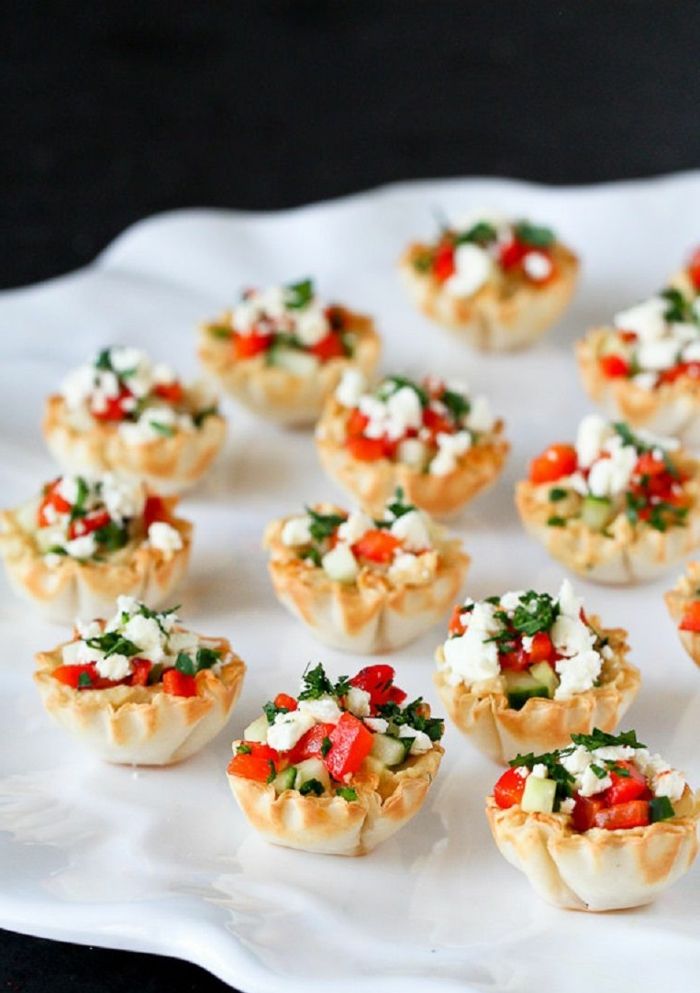 To minimize the risk, refrain from cutting chicken in cubes and instead follow our age-appropriate guidelines. Also, be sure not to overcook chicken as this causes it to be dry and more challenging to chew and swallow. As always, make sure to create a safe eating environment and stay within arm’s reach of baby during meals.
To minimize the risk, refrain from cutting chicken in cubes and instead follow our age-appropriate guidelines. Also, be sure not to overcook chicken as this causes it to be dry and more challenging to chew and swallow. As always, make sure to create a safe eating environment and stay within arm’s reach of baby during meals.
For more information on choking, visit our section on gagging and choking and familiarize yourself with the list of common choking hazards.
Is chicken a common allergen?
No. Chicken is not a common food allergen. However, cases of poultry allergy have been reported.4 5 Chicken has been reported as a trigger for FPIES (Food Protein-Induced Enterocolitis Syndrome), which results in delayed vomiting with or without diarrhea 2 to 4 hours after the ingestion of chicken meat. While rare, certain individuals with fish allergies may have an increased risk of being sensitive to chicken.6 Some individuals with known allergy to feather and egg also have positive allergy test results to chicken meat.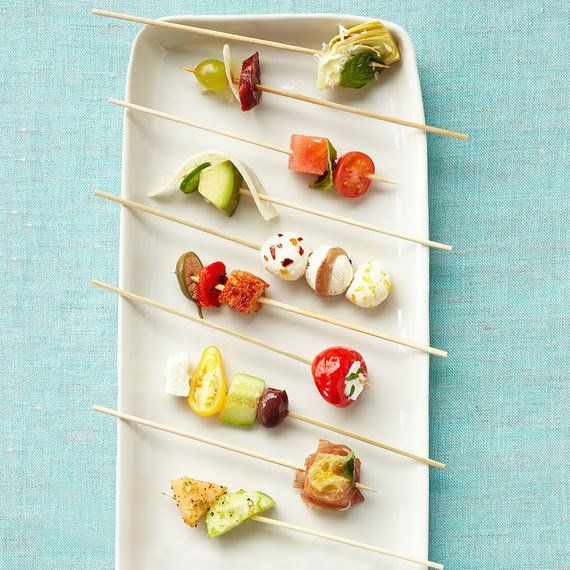 7 However, this does not commonly result in symptoms after the ingestion of well-cooked meat, as the allergenic protein is heat sensitive. Therefore, routine testing for chicken meat allergy is not recommended in cases of egg allergy.
7 However, this does not commonly result in symptoms after the ingestion of well-cooked meat, as the allergenic protein is heat sensitive. Therefore, routine testing for chicken meat allergy is not recommended in cases of egg allergy.
As you would when introducing any new food, start by offering a small quantity during the first couple of servings. If there is no adverse reaction, gradually increase the amount over future meals.
How do you prepare chicken for babies with baby-led weaning?
Every baby develops on their own timeline, and the suggestions on how to cut or prepare particular foods are generalizations for a broad audience. Your child is an individual and may have needs or considerations beyond generally accepted practices. In determining the recommendations for size and shape of foods, we use the best available scientific information regarding gross, fine, and oral motor development to minimize choking risk. The preparation suggestions we offer are for informational purposes only and are not a substitute for child-specific, one-on-one advice from your pediatric medical or health professional or provider. It is impossible to fully eliminate all risk of a baby or child choking on any liquid, puree, or food. We advise you to follow all safety protocols we suggest to create a safe eating environment and to make educated choices for your child regarding their specific needs. Never disregard professional medical advice or delay in seeking it because of something you have read or seen here.
It is impossible to fully eliminate all risk of a baby or child choking on any liquid, puree, or food. We advise you to follow all safety protocols we suggest to create a safe eating environment and to make educated choices for your child regarding their specific needs. Never disregard professional medical advice or delay in seeking it because of something you have read or seen here.
6 to 9 months old: Go big! Serve a whole drumstick with the skin and any loose cartilage, pin bones, and fat removed. Babies love to pick up and munch on drumsticks—and it is fantastic for oral-motor skills. Baby will not likely consume much, and this is okay. If a too-big piece of meat is torn off, give baby time to work with the food before intervening. Babies have innate reflexes to help push food forward and spit it out before it gets far enough back to cause choking. Also keep in mind that chicken drumsticks, depending on how they’re cooked, can become brittle and easily breakable, especially at the edges.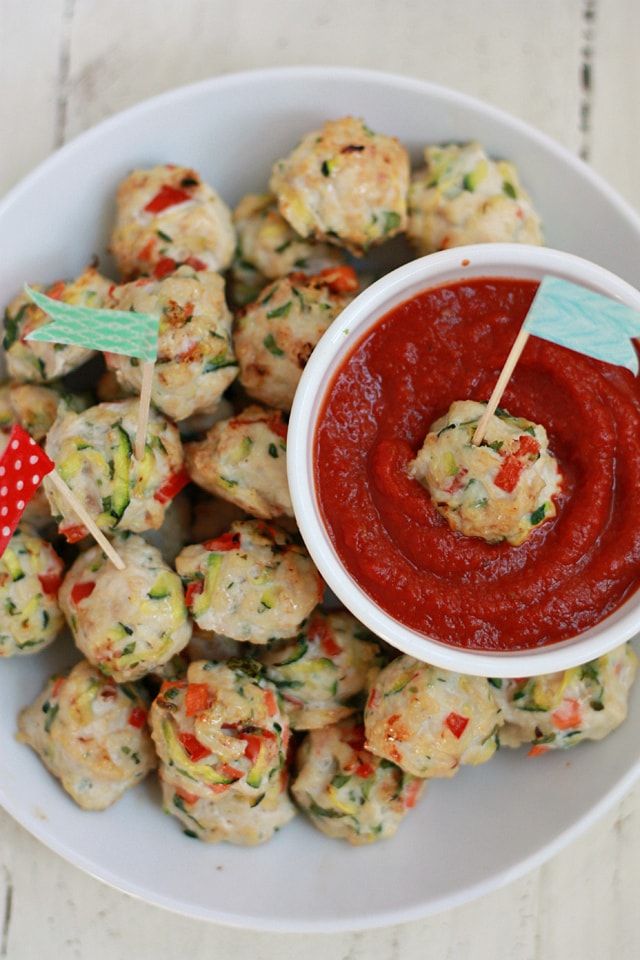 Cooking chicken for longer periods of time at lower temperatures can help prevent the bones from becoming brittle. We strongly recommend checking and testing the bone prior to offering by trying to bend it and pushing on the edges. Strong, firm bones are the way to go. If the bone breaks easily, crumbles at the edges, or splinters, the risk for bone to break off in baby’s mouth increases. In addition to drumsticks, you can serve chicken breast sliced into strips about the size of two adult fingers pressed together. Once a baby is able to bite and tear food (around 8 to 9 months of age), try serving thinner slices—about the size of an adult pinky finger. You can also serve ground chicken meatballs or meatloaf at this age as ground meats are soft and easy to mash with gums.
Cooking chicken for longer periods of time at lower temperatures can help prevent the bones from becoming brittle. We strongly recommend checking and testing the bone prior to offering by trying to bend it and pushing on the edges. Strong, firm bones are the way to go. If the bone breaks easily, crumbles at the edges, or splinters, the risk for bone to break off in baby’s mouth increases. In addition to drumsticks, you can serve chicken breast sliced into strips about the size of two adult fingers pressed together. Once a baby is able to bite and tear food (around 8 to 9 months of age), try serving thinner slices—about the size of an adult pinky finger. You can also serve ground chicken meatballs or meatloaf at this age as ground meats are soft and easy to mash with gums.
9 to 12 months old: Finely shred or slice chicken into very thin strips or offer ground chicken sprinkled on veggies, pasta, or any other dish. At this age, babies can get ambitious and start stuffing and shoveling food in their mouths. While a good learning experience, it can be quite stressful. Nervous? Shred the meat to minimize the risk.
While a good learning experience, it can be quite stressful. Nervous? Shred the meat to minimize the risk.
12 to 24 months old: Offer bite-sized pieces of chicken as finger food or let the toddler practice with a utensil. To reduce the risk of choking, refrain from offering chunks of chicken or serving perfectly sized cubes. When you feel a child’s eating skills have developed, increase the size of food by serving a whole drumstick with the skin, pin bones, and loose cartilage or fat removed.
A thin slice of chicken for babies 8 months+Bite-sized pieces of chicken for toddlers 12 months+Take the stress out of day-to-day cooking with our Meal & Recipe Ideas Kit.
Recipe: Simple Roast Chicken
Yield: 3 cups (420 grams)
Cooking Time: 1 hour
Age: 6 months+
Ingredients
- 1 whole chicken
- 3 tablespoons (45 milliliters) olive oil, separated
- 2 teaspoon (2 grams) dried oregano, parsley, rosemary, sage, or thyme (optional)
- 3 cups (450 grams) carrots, parsnips, potatoes, or root vegetables of choice (optional)
Directions
- If you are starting with frozen chicken, transfer the meat to the refrigerator to thaw the day before you plan to cook.
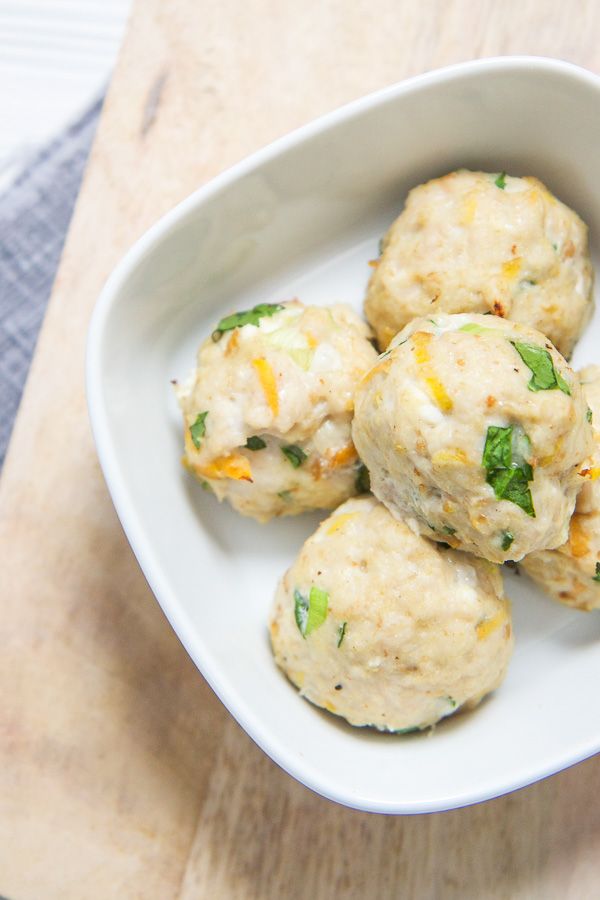
- Pre-heat the oven to 400 degrees Fahrenheit (205 degrees Celsius).
- Remove any giblets from the inside of the chicken and reserve for another use. Season the chicken with 2 tablespoons of olive oil and the herbs.
- Wash, dry, peel, and cut the root vegetables into spears.
- Transfer the vegetables to a roasting pan. Coat with the remaining 1 tablespoon of oil.
- Place the chicken on top of the vegetables.
- Roast until the chicken skin is golden brown, between 45 and 60 minutes. Use a kitchen thermometer to measure the chicken’s internal temperature in the thickest part of the thigh: the chicken is done when the temperature has reached 165 degrees Fahrenheit (74 degrees Celsius).
- Remove the pan from the oven. Use tongs to tilt the chicken in the pan to drain the juices in the cavity. Transfer the chicken to a cutting board. Let the chicken rest for 15 minutes.
- Carve the chicken into parts—drumstick, thigh, and breast. Save the carcass and bones to make chicken stock.

- Remove the skin and any loose meat or cartilage from the child’s portion and cut into age-appropriate sizes. Cool the meat to room temperature before serving.
- Serve: Let baby self-feed with hands. If help is needed, pass a drumstick in the air for them to grab from you or remove the meat from the bones and shred.
To Store: Cooked chicken keeps in an air-tight container in the fridge for 3 days or in the freezer for 4 months. Store the carcass in an air-tight container in freezer to use at a later date to make chicken stock.
Dinnertime fast approaching and all out of ideas? Our dinner guide has 100 baby- and toddler-friendly recipes that are easy to make, each accompanied with gorgeous photos.
Flavor Pairings
Chicken is versatile! The plain meat pairs just as well with rich, fatty foods like almond, avocado, butter, cashew, coconut, peanut butter, pistachio, and yogurt as with nutrient-packed vegetables like broccoli, cauliflower, carrot, pumpkin, purple potato, and sweet potato and leafy greens like bok choy, collard greens, kale, and spinach. Try serving chicken alongside nutty grains like freekeh, Khorasan wheat, quinoa, and rice and mixing in fruits like apple, pear, pomegranate, or pineapple to bring out its sweetness. Chicken can taste pretty mild, so try seasoning the meat with garlic, lemon, or aromatics and herbs like achiote, lemongrass, saffron, and thyme to add layers of flavor.
Try serving chicken alongside nutty grains like freekeh, Khorasan wheat, quinoa, and rice and mixing in fruits like apple, pear, pomegranate, or pineapple to bring out its sweetness. Chicken can taste pretty mild, so try seasoning the meat with garlic, lemon, or aromatics and herbs like achiote, lemongrass, saffron, and thyme to add layers of flavor.
Reviewed by
J. Truppi, MSN, CNS
V. Kalami, MNSP, RD
K. Grenawitzke, OTD, OTR/L, SCFES, IBCLC, CNT
S. Bajowala, MD, FAAAAI. (allergy section)
R. Ruiz, MD, FAAP Board-Certified General Pediatrician and Pediatric Gastroenterologist
- Ahmad, S., Rehman, R., Haider, S., Batool, Z., Ahmed, F., et al. (2018). Quantitative and qualitative assessment of additives present in broiler chicken feed and meat and their implications for human health. Journal of Pakistan Medical Association, 68(6),876-881. PMID:30325904. Retrieved April 12, 2021.
- Ponte, P.
 I., Rosado, C.M., Crespo, J.P., Crespo, D.G., Mourão, J.L., et al. (2008). Pasture intake improves the performance and meat sensory attributes of free-range broilers. Poultry Science, 87(1), 71-79. DOI:10.3382/ps.2007-00147. Retrieved April 12, 2021.
I., Rosado, C.M., Crespo, J.P., Crespo, D.G., Mourão, J.L., et al. (2008). Pasture intake improves the performance and meat sensory attributes of free-range broilers. Poultry Science, 87(1), 71-79. DOI:10.3382/ps.2007-00147. Retrieved April 12, 2021. - Dewey-Mattia, D., Manikonda, K., Hall, A.J., Wise, M.E., Crowe, S.J. (2018). Surveillance for Foodborne Disease Outbreaks — United States, 2009–2015. Surveillance Summaries, 67(10), 1–11. Retrieved April 12, 2021.
- Zacharisen M.C. (2006). Severe allergy to chicken meat. Wisconsin Medical Journal: Official Publication of the State Medical Society of Wisconsin, 105(5), 50–52. PMID:16933414. Retrieved April 12, 2021.
- Kuehn, A., Codreanu-Morel, F., Lehners-Weber, C., Doyen, V., Gomez-André, S.A. (2016). Cross-Reactivity to Fish and Chicken Meat—A New Clinical Syndrome. Allergy, 71(12), 1772–1781. DOI:10.1111/all.12968. Retrieved April 12, 2021.
- Kuehn, A., Codreanu-Morel, F., Lehners-Weber, C.
 , Doyen, V., Gomez-André, S.A. (2016). Cross-Reactivity to Fish and Chicken Meat—A New Clinical Syndrome. Allergy, 71(12), 1772–1781. DOI:10.1111/all.12968. Retrieved April 12, 2021.
, Doyen, V., Gomez-André, S.A. (2016). Cross-Reactivity to Fish and Chicken Meat—A New Clinical Syndrome. Allergy, 71(12), 1772–1781. DOI:10.1111/all.12968. Retrieved April 12, 2021. - Hemmer W, Klug C, Swoboda I. (2016). Update on the bird-egg syndrome and genuine poultry meat allergy. Allergo Journal International, 25:68-75. doi:10.1007/s40629-016-0108-2. Retrieved June 28, 2021.
Manufacturer of chicken baby food "Kudashka"
Skip to content
This is the same village chicken that both children and their parents missed so much.
This is the same village chicken that both children and their parents missed so much.
Chicken thighs in a hurry
Ingredients 4 persons 75 minutes Main course Chicken thighs on the bone 4-5 pcs. Carrot 1 pc. Onion 1 pc. Sour cream 200 gr. For a garnish 100 g rice 3 g salt a bunch of greens Svyatoslav Kurochkin Here is a description of the cook of the author of the recipe. Here's the chef's description author Why this original recipe is good The cooking method is suitable even for small children.…
Here's the chef's description author Why this original recipe is good The cooking method is suitable even for small children.…
Vegetable soup with chicken meatballs (balls)
Ingredients 4 persons 75 minutes Main course Potatoes 3-4 pcs. Carrot 1 pc. Onion 0.5 pcs. Tomatoes 1-2 pcs. Canned corn 100 gr. Chicken meatballs For garnish 100 g rice 3 g salt a bunch of greens Svyatoslav Kurochkin Here is a description of the author of the recipe cook. Here is the chef's description author Why this original recipe is good The method of preparation is suitable even for…
Chicken soup with vegetables
Ingredients 4 persons 75 minutes Main course Chicken breast fillet 500 gr. Potatoes 3-4 pcs. Broccoli 400 gr. Cauliflower 400 gr. Cream (milk) - optionally 200 ml. For a garnish 100 g rice 3 g salt a bunch of greens Svyatoslav Kurochkin Here is a description of the cook of the author of the recipe. Here is the chef's description author What is good about this original recipe…
Steamed chicken baby soufflé
Ingredients 4 persons 75 minutes Main course Chicken breast fillet 600 gr.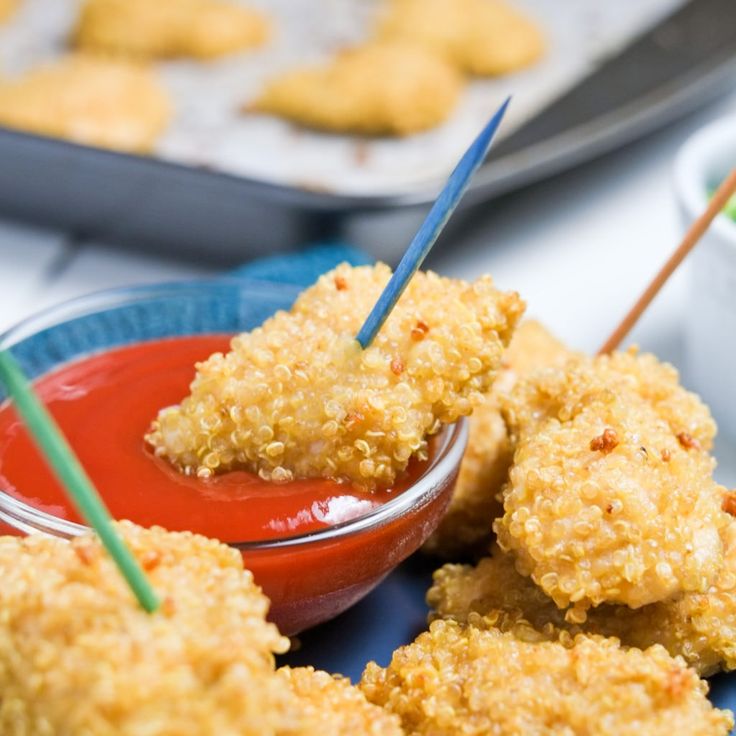 Egg 1 pc. Cream or milk 100 ml. Salt To taste For garnish 100 g rice 3 g salt a bunch of greens Svyatoslav Kurochkin Here is a description of the author of the recipe cook. Here is the chef's description author Why this original recipe is good The cooking method is suitable even for little ones…
Egg 1 pc. Cream or milk 100 ml. Salt To taste For garnish 100 g rice 3 g salt a bunch of greens Svyatoslav Kurochkin Here is a description of the author of the recipe cook. Here is the chef's description author Why this original recipe is good The cooking method is suitable even for little ones…
Braised chicken breast in sour cream sauce
Ingredients 4 persons 75 minutes Main course Chicken breast 800 gr. Onion 0.5 pcs. Sour cream 300 gr. Vegetable oil 2 tbsp Salt, spices To taste For garnish 100 g rice 3 g salt a bunch of greens Svyatoslav Kurochkin Here is a description of the author of the recipe. Here is a description of the chef author Why this original recipe is good The cooking method is suitable even ...
Chicken soufflé in a slow cooker
Ingredients 4 persons 75 minutes Main course Chicken fillet 500 gr. Egg 1 pc. Onions, carrots 1 pc. Cream or milk 200 ml. Spices, salt To taste White bread 100 gr. For a garnish 100 g rice 3 g salt a bunch of greens Svyatoslav Kurochkin Here is a description of the cook of the author of the recipe. Here is the description of the chef by Chem…
Here is the description of the chef by Chem…
Rice soup in a slow cooker with chicken
Ingredients 4 persons 75 minutes Main course Water 1.5 l. Any cut of chicken (legs, legs, fillet) 300 gr. Potatoes 2-3 pcs. Onion 1 pc. Carrot 1 pc. Fig 2 tbsp. spoons Salt, spices To taste For garnish 100 g rice 3 g salt a bunch of greens Svyatoslav Kurochkin Here is a description of the author of the recipe. Here is a description…
chicken meatballs
Ingredients 4 persons 75 minutes Main course Chicken breast fillet 500 gr. Chicken thigh fillet 300 gr. Onion 1 pc. Salt 1 pc. For a garnish 100 g rice 3 g salt a bunch of greens Svyatoslav Kurochkin Here is a description of the cook of the author of the recipe. Here is the chef's description author Why this original recipe is good The cooking method is suitable even for little ones…
Chicken soup with noodles in a slow cooker
Ingredients 4 persons 75 minutes Main course Water 1-1.5 l. Chicken legs 2 pcs. Potatoes 2-3 pcs. Onion 0.5 bulbs Carrots 1 pc. Vermicelli 100 gr. Salt, spices To taste For garnish 100 g rice 3 g salt a bunch of greens Svyatoslav Kurochkin Here is a description of the author of the recipe. Here is a description of the chef author What is good about this original ...
Potatoes 2-3 pcs. Onion 0.5 bulbs Carrots 1 pc. Vermicelli 100 gr. Salt, spices To taste For garnish 100 g rice 3 g salt a bunch of greens Svyatoslav Kurochkin Here is a description of the author of the recipe. Here is a description of the chef author What is good about this original ...
Vegetable stew with chicken
Ingredients 4 persons 75 minutes Main course Chicken breast 300-400 gr. Potatoes 500 gr. Zucchini 1 pc. Eggplant 1 pc. Cauliflower 400 gr. Broccoli 200 gr. Onions, carrots - for frying 1 pc. Sunflower oil Salt, spices To taste For garnish 100 g rice 3 g salt a bunch of greens Svyatoslav Kurochkin Description here…
Chicken quenelles
An unusually tasty and extremely tender dish that your child will definitely like
chicken sausage
Homemade sausage is the best snack product. It can be used instead of the store if you need a quick bite to eat. It is tasty, tender and absolutely harmless to the body.
Chicken schnitzels
Delicate and tasty second course for children.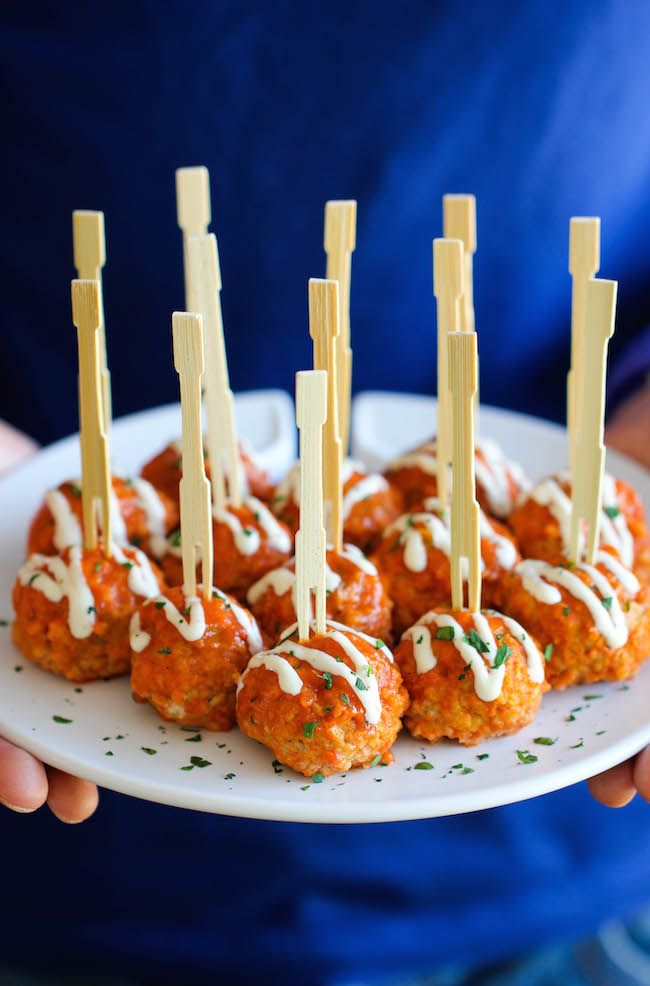 The usefulness of this dish for the growing body of the child is undeniable. Small-sized schnitzels have the maximum calories needed by the baby. At the same time, they do not overload his digestive tract beyond the norm.
The usefulness of this dish for the growing body of the child is undeniable. Small-sized schnitzels have the maximum calories needed by the baby. At the same time, they do not overload his digestive tract beyond the norm.
Chicken and Celery Soup
The celeriac chicken soup method is suitable even for small children. The fat content of the dish will be minimal, while all the useful substances will remain in it.
Chicken meatballs
Steamed chicken meatballs for feeding kindergarten children
chicken hearts
Although this dish should not be given daily, it is worth including it in your baby's diet for its great benefits
chicken broth baby recipe
Chicken broth, will satisfy all the needs of the child in the necessary calories, nutrients and vitamins without harm to his body.
Chicken nuggets
Not the healthiest dish for children, but on special days it can be served as a festive meal
Vermicelli soup
To make the chicken broth soup your baby like it, you should prepare it only from proven products and according to our recipe
Soup with dumplings
This recipe is different because it cooks very quickly
Chicken sandwich with cheese
Delicious, high-calorie, and at the same time, dietary dish will please your child at school, bringing him a real pleasure of taste
Chicken skewers
A festive and tasty dish that all children love so much, especially as part of the holiday menu
Chicken sausages
to feed your child quickly and tasty it is not necessary to spend a lot of time and look for special products, just read our recipe
Chicken meatballs
Ingredients 4 persons 75 minutes Main course 300 g chicken fillet “Kudashka” 2 tbsp. l. flour 1 pc. egg 1 pc. onion 100 g boiled rice 1 pc. carrots 100 ml. sour cream 15% 1 tbsp. l. tomato juice from fresh tomatoes 1 sprig each fresh parsley and dill 3 g salt For garnish 100 g…
l. flour 1 pc. egg 1 pc. onion 100 g boiled rice 1 pc. carrots 100 ml. sour cream 15% 1 tbsp. l. tomato juice from fresh tomatoes 1 sprig each fresh parsley and dill 3 g salt For garnish 100 g…
Chicken legs for kids recipe
This dish is famous for its ease of preparation and healthy consumption. It will allow you to quickly and tasty feed the child and will become one of his favorites in menu
chicken salad
Of the many chicken dishes, the most attractive is chicken souffle, which is most suitable for feeding children in kindergarten
Chicken cutlets
Of the many chicken dishes, the most attractive is chicken souffle, which is most suitable for feeding children in kindergarten
Chicken with carrots
Of the many chicken dishes, the most attractive is chicken soufflé, which is most suitable for feeding children in kindergarten
Chicken with tomatoes
Of the many chicken dishes, the most attractive is chicken souffle, which is most suitable for feeding children in kindergarten
Chicken soufflé
Chicken soufflé baby food benefits include nutrition, digestibility, energy value and calorie content. In addition, it is hypoallergenic, belongs to the diet and is recommended for feeding children of younger groups of kindergartens. The delicate texture of this dish, as well as its excellent taste, made it possible to use the chicken soufflé recipe for children in the kitchens of the canteens of preschool educational institutions.
In addition, it is hypoallergenic, belongs to the diet and is recommended for feeding children of younger groups of kindergartens. The delicate texture of this dish, as well as its excellent taste, made it possible to use the chicken soufflé recipe for children in the kitchens of the canteens of preschool educational institutions.
Top
Carrots with chicken - Encyclopedia Baby food
Levchuk Victoria © Levchuk Victoria ©Carrots with chicken is a very easy recipe, and since children can rarely eat boiled carrots, you can cook this dish once a week as minimum. You can take pieces of fillet, but it turns out dry meat and it is difficult to chew, and if you take minced chicken and make meatballs, the child will like it more. We try, the combination of carrots and chicken is simply delicious.
Serves: servings
Instructions
-
Place the carrot and chicken pieces in a saucepan with enough vegetable stock (water may be used) and ground cumin (if the spice is included in the baby's diet).
 You can cook vegetables and chicken in a double boiler, slow cooker, pressure cooker or just on fire.
You can cook vegetables and chicken in a double boiler, slow cooker, pressure cooker or just on fire. -
Mix well.
-
Chicken meatballs can be used instead of chicken pieces.
-
Close the lid and cook for 1-2 hours, or until the chicken is cooked, it is important that the carrots are completely boiled, for this it is best to cut them finely enough.
-
Grind carrots and chicken in a blender or press. If the baby is older, then you can mash slightly, then the chicken will be small soft pieces.
-
Add a few drops of vegetable oil.
-
Add boiled water, breast milk, milk formula, or vegetable broth to achieve a smooth, tender consistency.
-
If the child eats finger food, then you can not blend.
-
The child tries to eat with a spoon.
-
Here he is trying to eat with a fork.
-
Since it is not always possible to prick food with a fork, the child takes a piece in his hands and pricks it on the fork.

-
The taste of the dish is sweet-meat, very tasty, herbs just add a little spice.
We are not afraid and add me to VK and Odnoklassniki, Instagram!
Like this article? Subscribe to site updates
Encyclopedia Baby Food!
Don't forget to bookmark us! (CTRL+SHIFT+D) Subscribe to the site, comment, share in social networks.
On our website Encyclopedia Baby Food there is useful information on the nutrition of your children, which is useful for everyone, and we update the website "Encyclopedia Baby Food" constantly and try to search and write only excellent, verified and necessary information for you and your children.
Disclaimer No. 1: It must be understood that the author of the articles on the Baby Food Encyclopedia website is not a medical staff, “I am not a doctor.” The information I share is based on my own experience. My goal is not to teach you how to eat or feed your child, but to talk about how we did it, what new things I learned or read. This expands the picture of Baby Food knowledge, gives you a glimpse of the whole process so you can decide if you like it or not.
This expands the picture of Baby Food knowledge, gives you a glimpse of the whole process so you can decide if you like it or not.
Disclaimer No. 2 : However, the above does not cancel visiting a pediatrician. Before you start complementary foods, you need to get his professional opinion on the best way to introduce new foods for your baby. I also draw your attention to the fact that you need to look at the original date of the published articles, because some of the "best practices" may have changed. Always check with your child's pediatrician about complementary foods and their health.
Disclaimer #3: Keep in mind that every family is unique, every situation is also completely unique. There are no universal solutions. Only you can find what works best for you. Certain goals require certain sacrifices and priorities - not everyone wants to make those choices, and that's GREAT! Just know what you want to achieve, and be ready to get to work, putting the best of your strength!
Disclaimer No. 4: On the Encyclopedia Baby Food website, photos from books on baby food with attribution are used to better understand the information (Article 1274, paragraph 1, part four of the Civil Code of the Russian Federation). Literature on baby food is found in the public domain on the Internet.
4: On the Encyclopedia Baby Food website, photos from books on baby food with attribution are used to better understand the information (Article 1274, paragraph 1, part four of the Civil Code of the Russian Federation). Literature on baby food is found in the public domain on the Internet.
Apricot puree with chicken
Banan-global puree
Banana puree
borsch
broth with peas and rice
Botterbrod with kolrabi
Fixed dessert from zucchini with strawberries
Salary cigaret Buckwheat porridge with apricots
Buckwheat porridge with banana
Buckwheat pilaf
Children's sausage
Children's milk porridge with banana
Children's vinaigrette
Children's ketchup
Children's cucumber salad
Children's salad Olivier
Children's porridge biscuits
Children's puree of strawberries, bananas, yellow cherries, yoghurt and biscuits with cereals
Children's puree with cottage cheese and fruits
Homemade yeast bread with flaxseed flour
Homemade cheese
Homemade pizza
5 Breakfast outside Kohlrabi appetizer
Roasted cauliflower
Roasted carrots
Roasted carrots and cherries with millet
Winter salad with Jerusalem artichoke
Cabbage with white beans
Cabbage salad like in a canteen
Mashed potatoes
Quinoa and pumpkin porridge
Quinoa porridge
breakfast porridge
Quinoa and apple
Strawberry puree
Strawberry puree with banana
Strawberry compote
Wild apple and raspberry compote
Thermo-steamed fruit compote for older children 8 months
Corn porridge
Corn porridge with pear
Corn porridge with pumpkin
Corn porridge with pumpkin and carrots
Corn porridge with apple and carrots
Chicken liver in the oven
Chicken cutlets with carrots
Chicken with carrots, bell peppers and potatoes
Navy pasta
Pasta with orange sauce
Gremolata pasta
Muffins with vegetables and egg
Jacket new potatoes
Milk vermicelli soup4 Carrot puree5
Carrot-rice casserole
Carrot with chicken
Egg and tomato fly agaric
Meat envelopes
Tarragon homemade drink for children
Cauliflower and carrot vegetable puree
Vegetable soup with corn semolina
Vegetable soup with cheese and corn semolina
Vegetable soup with spinach
Vegetable puree soup with bell pepper
Oatmeal porridge
Pollock fritters
Hot kefir fritters
Cauliflower omelette 90 in a bag
Spinach and Cheese Omelette
Omelet Pancake
Peach Puree
Baked Apples 7 months +
Zucchini and Carrot Pie
Zucchini Pie
Rice and Zucchini Pie
Fish Pie
Fish and potato pie
White cabbage pizza
Lavash pizza
Zucchini, tomato and sausage pizza
Tomato and olive pizza
Spinach pizza
Rabbit pilaf
Chicken pilaf with green peas and corn Puree 9045 and cherries
Banana, cottage cheese and porridge puree 4 cereals
Broccoli (cauliflower) puree
Broccoli, courgette and cauliflower puree
Blueberry puree
Pear puree
Pear and banana puree
Baked pear and banana puree
Pear and pumpkin puree 7 months +
Pear, pumpkin and peach puree
Pear, apple, plum and prunes puree
Blackberry puree
Turkey puree
Zucchini puree 90 zucchini and broccoli
Zucchini, carrot and potato puree
Quinoa and banana puree
Quinoa and carrot puree
Quinoa, banana and carrot puree
Quinoa, squash and carrot puree
Quinoa, peach and raspberry puree
quinoa, cauliflower, apple, peas and mint
Quinoa, apple, pear and raisin puree
Quinoa, apple, carrot puree
Rabbit, broccoli and cauliflower puree
Chicken, carrot, potato, apple and pea puree
Raspberry, cherry and banana puree
carrots
Carrot and apple puree
Carrot, potato, broccoli puree with cheese
Carrot, potato, apple and quinoa puree
Carrot, pumpkin, apple and prune puree
Carrot, apple and potato puree
Turnip and carrots
Plum puree
Cottage cheese, strawberry and banana puree
Pumpkin puree
Pumpkin and banana puree
Pumpkin and squash puree
Pumpkin and apple puree
Pumpkin, apple and banana puree
Cauliflower and broccoli puree
Cauliflower puree and potatoes
Cauliflower and rice puree
Cauliflower and apple puree
Cauliflower, green peas and squash puree
Cauliflower, turkey and potato puree
Cauliflower, potato and squash puree
Cauliflower, carrot and broccoli puree
Cauliflower, carrot, cheese and rice puree
Cauliflower, apple and courgette puree
Zucchini puree
Zucchini and potato puree
Zucchini, carrot and apple puree 90 cherries
Blueberry puree
Prune puree
Apple, pumpkin, carrot and some curry puree
Apple and pear puree
Apple and strawberry puree
Apple, strawberry and cherry puree
Apple, peach and banana puree
Carrot and pumpkin puree
Cottage cheese and banana puree
Turkey, potato and carrot stew
Zucchini, carrot and broccoli stew
Fish, potato, carrot and broccoli stew
Rice porridge
Whole grain rice porridge
carrot
Rice porridge with pumpkin
Rice porridge with apples
Rice porridge with apple and pear
Rice porridge with apple and pumpkin
Fish cakes with vegetables
Semi-cooked fish
Fish meatballs with ketchup
Baby Fish Soup
Salmon and Celery Fish Soup
Carrot and Kohlrabi Salad
Chickpea Salad
Chickpea and Cabbage Salad
Laziest Soup
Creamy Kohlrabi Soup
Oatmeal Smoothie 90 Sauce Pot
Cheesy Pizza
Pea and Bacon Soup
Baked Vegetable Soup
Kohlrabi Soup
Salmon Soup
Cauliflower Soup
Turnip Potato Soup
Meatball Soup for the Picky Eater
Kohlrabi soup with green apple
Rabbit, pumpkin, potato, broccoli and cauliflower soup
Beetroot soup
Pumpkin soup with mushrooms
Broccoli and celery soup
Soup/stew Pork with Potatoes and Carrots
Cheese Pasties
Pumpkin Cheese Sauce (Annabelle Carmel Recipe)
Buzz Lightyear Sandwich
Pumpkin Apple Puree
Pumpkin Apple Juice
Pumpkin Cake
Pumpkin Soup9 Puree
Fruit Salad 8 Bread lavash
Cauliflower with cheese
Linden tea and thyme
Experimental noodle soup with lentils
Apple puree
Apple juice
Don’t be afraid and add me to VK and Instagram, Odnoklassniki!
Like this article? Subscribe to site updates
"Encyclopedia Baby Food"!
Don't forget to bookmark us! (CTRL+SHIFT+D) Subscribe to the site, comment, share in social networks.

On our site Encyclopedia Baby Food there is useful information on the nutrition of your children, which is useful for everyone, and we update the site "Encyclopedia Baby Food" constantly and try to search and write only excellent, verified and necessary information for you and your children.
Disclaimer No. 1: It must be understood that the author of the articles on the Baby Food Encyclopedia website is not a medical staff, “I am not a doctor.” The information I share is based on my own experience. My goal is not to teach you how to eat or feed your child, but to talk about how we did it, what new things I learned or read. This expands the picture of Baby Food knowledge, gives you a glimpse of the whole process so you can decide if you like it or not.
Disclaimer No. 2 : However, the above does not cancel visiting a pediatrician. Before you start complementary foods, you need to get his professional opinion on the best way to introduce new foods for your baby.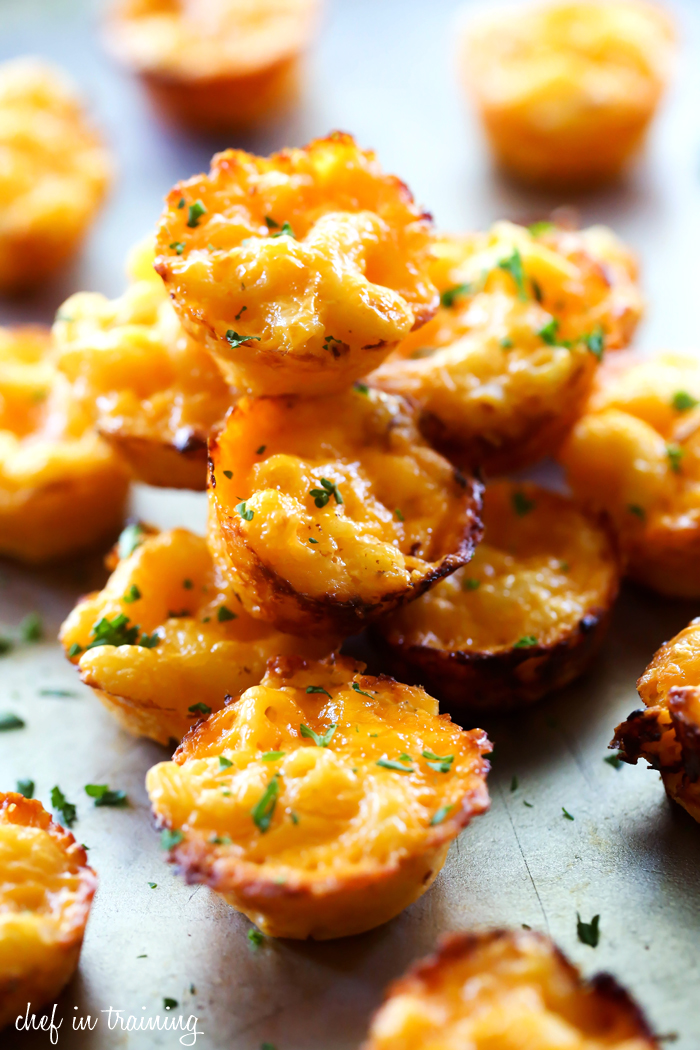 I also draw your attention to the fact that you need to look at the original date of the published articles, because some of the "best practices" may have changed. Always check with your child's pediatrician about complementary foods and their health.
I also draw your attention to the fact that you need to look at the original date of the published articles, because some of the "best practices" may have changed. Always check with your child's pediatrician about complementary foods and their health.
Disclaimer #3: Keep in mind that every family is unique, every situation is also completely unique. There are no universal solutions. Only you can find what works best for you. Certain goals require certain sacrifices and priorities - not everyone wants to make that choice, and that's GREAT! Just know what you want to achieve, and be ready to get to work, putting the best of your strength!
Disclaimer No. 4: On the Encyclopedia Baby Food website, photos from books on baby food with attribution are used to better understand the information (Article 1274, paragraph 1, part four of the Civil Code of the Russian Federation). Literature on baby food is found in the public domain on the Internet.




